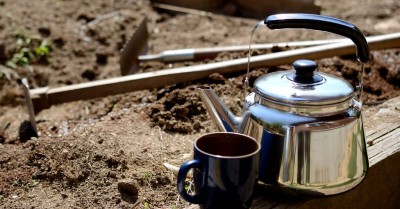
bringing nature, nurseries and gardeners together April 23, 2021
|
|
Cultivate Celebration: drop by this new south Austin nursery for its 'Spring Garden Market' event on Sunday, April 25 from 11 – 4 p.m. Music by Ley Line, a plant & seed swap, and local vendors will be on site. (Masks required) Complete details here: Cultivate events ❦

Fig cottage: this was the name artist Linda Anderson had chosen for her east Austin home, and it was fitting because of the enchanting woodland of fig trees at the front of her house . . . until the great Valentine's week storm. Though devastated by the loss, she is back to feeling at least a little positive as the fresh leaves come back at the base of her trees.
_______________________________________________
We got the beets: "I don’t know about y’all but we have been getting so many beets in our boxes that we are starting to run out of ideas on how to use them!" writes Ada Broussard on the Johnson's Backyard Garden blog. Her solution? Dehydrating them and using the powder to dye clothes, add to smoothies, and as a food dye. JBG-Organic ❦
Lights out Texas: lots of our feathered friends are migrating at the moment, and we can help them navigate their way to their summer homes by turning off our outdoor lights. Audubon ❦

Hancock golf course-to-park: there's no kite-flying or picnicing on great lawns at this central golf course right now - but there could be. Please join us to help heal the land and open up what will someday be a crown jewel in Austin's park system. Hancock Conservancy Many thanks to artist Linda Anderson for this original painting. ❦
_______________________________________________
Central Texas Gardener: Native clumping grasses bring beauty, wildlife habitat, and floodwater control to sun and shade gardens. Sedges are perfect for shady spots where they can mimic the look of lawn. KLRU
 How to Brew Compost Tea
by Chris Winslow
With the heat of the summer months just around the corner, it will soon be time to give a tall glass of iced tea to gardeners . . . and generous amounts of compost tea to our plants.
This tea contains millions of beneficial organisms, and plants love it. All you have to do is fill an old pillowcase with some compost and a few other ingredients, use some simple aquarium pumps to keep everything moving… and let it steep overnight.
Compost tea is truly amazing. It is highly nutritious, adding beneficial bacteria and micorrhizal fungi to the soils. It has fungicidal properties as well. These beneficial bacteria and micorrhizal fungi increase the surface absorbing area of roots. This, in turn, increases a plant’s ability to absorb nutrients.
The recipe we used to brew at the nursery (see below) is on a fairly large scale. It yields 55 gallons of tea, and has to be used almost immediately. If this seems like it is too much, you can halve the ingredients, or get your neighbors and community garden friends involved.
Ingredients:
1. A barrel to hold water. We used a 55 gallon rain barrel.
2. Water. Rainwater would be the best. If you have chlorinated water, let it sit a day or two before starting your project.
3. A giant tea bag, such as an old pillowcase, a tea towel, or a stocking.
4. Two small pumps, available in aquarium shops. One will re-circulate the water, the other will run an air stone.
5. Compost: we use 2 or 3 pounds of store-bought earth worm castings.
6. A cup of Bio-Start by Espoma (beneficial bacteria and micorrhizal fungus).
7. Half a cup of either dry or liquid molasses to feed the beneficial bacteria.
Place the earthworm castings, molasses, Bio-Start, and the air stone into the tea bag and secure open end with string or rubber bands.
Place the tea bag into the barrel with water and plug in the re-circulating pump and air stone.
Allow the system to run overnight. By next morning it will be ready to use. Compost tea should be used within a day. Its shelf life can be extended for a day or two with the addition of more molasses and continued aeration.
You now have 55 gallons of compost tea that can be sprayed on plant foliage and drenched at the root zone and added to the garden soil.
I can’t think of anything better for the enrichment of your garden and stress relief during the upcoming dog days of summer days. Happy gardening everyone! ❦
|
 It's About Thyme Legacy Publications.
Contact newsletter editor Darrel Mayers with any ideas for articles or interesting links at internationalrain@yahoo.com (hitting 'reply' to this email won't work) |
|
|